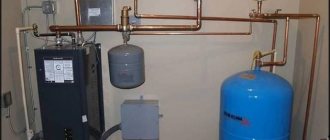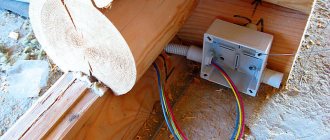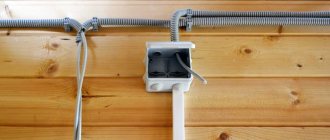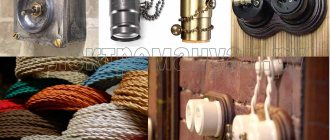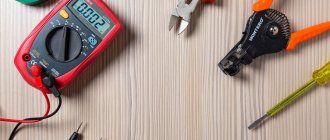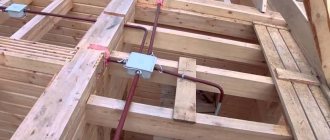The desire of residents of large cities to escape the pollution of megacities and live quietly in their cottages in nature is causing rapid construction of private houses. People most often choose environmentally friendly designs from:
- plain or rounded logs;
- glued or regular timber;
- frame blocks.
The construction of such buildings requires taking into account the performance properties of wood and products made from it.
Design features of wooden houses that influence the choice of heating systems
When choosing a heating scheme for a wooden house, you should consider:
- number of storeys;
- volume of premises;
- shrinkage ability of the building;
- floor construction made of boards on joists.
The number of floors and the capacity of the heated space influence the choice of heating system based on performance, which should create comfortable living conditions even in cold weather.
The fibrous structure of wood contains air, which prevents heat transfer and serves as a good natural heat insulator. However, over time, the relative humidity of even prepared dried wood decreases. The drying process is especially noticeable after the first year of operation of the building, in which the proportions are slightly reduced, and cracks form at the tightly fitted joints of the boards.
Changing the geometry of the walls can not only deform vertical pipelines, but also break their tightness.
In order to prevent such breakdowns, heating is installed a year after the wooden frame is assembled or expansion loops and other devices are used at pipe joints.
When designing electric heating in a wooden house, one should take into account the shrinkage, shrinkage and fire hazard of wood, not forgetting the general thermal insulation.
In this case you can use:
- water/liquid electric boiler, powered by electricity and controlled by an automation system;
- warm floor;
- direct electric heating: radiators and convectors;
- infrared radiation;
- baseboard heating;
- scheme of forced or natural circulation of warm air.
How to save on electric heating
A convenient type of heating with electricity is not such a cheap pleasure, so it is necessary to take measures to reduce its cost. First, the power of electric heating is calculated. For an approximate calculation of thermal power, take 30 W per 1 m³.
Distribution of warm air in a room with convection heating and comfortable infrared heating
Power can be calculated more accurately using special programs. The next step in saving energy is to use a thermostat with a temperature sensor. Optimal thermal conditions will help save electrical energy. Installing a two-tariff meter will also reduce the cost of electricity. Good insulation of a wooden house is also important.
Wood retains heat perfectly, and if you also seal all the cracks, windows and doors, you can save electricity on electric heating twice as much. I would like to note that gas heating is by far the cheapest heating option, so if it is possible to connect to a gas pipeline, do so.
Did the article help you?
Electric boiler
The most effective industrial designs and home-made devices made by folk craftsmen allow you to choose a liquid heating scheme for a wooden house, taking into account climatic and financial capabilities.
When using a system for transferring heat to rooms using radiators, you should consider the piping layout. It can be two-pipe or single-pipe. Each of them has its own advantages. They should be carefully analyzed at the design stage.
Industrial designs of electric boilers use a built-in automation circuit set up in the factory. If you manufacture an electric boiler yourself, you will have to manually regulate its operation or install an additional control and temperature monitoring system.
The automation algorithm will need to take into account the operation of the temperature controller, the safety unit - a safety valve with a pressure gauge, a minimum temperature sensor, a check valve, pressure and anti-condensation pumps, and a water replenishment circuit in the system.
Electricity from alternative sources can be used to heat water from heating elements. A simple homemade wind generator connected without a controller directly to thermal electric heating elements can effectively heat water.
The only condition is that you will have to provide a circuit for putting it into operation: in a cold state, the nichrome wire of the heater has a low ohmic resistance, which will bypass the output circuits of the wind generator. Before connecting it, you will need to heat the nichrome with currents from a stationary network. The resistance of the heating elements will increase and allow the generator to operate.
The energy of a solar battery can be used in the same way, although the integrated inclusion of a wind generator in an electric home solar station is considered the most promising option.
How to choose a heater
What should you pay attention to first when choosing the best heater?
Price
Obviously, the price varies depending on the type and functionality of the heater. First of all, the cost is affected by the heated area - the larger it is, the more expensive the purchase will be. For example, you can buy the simplest device for 600 rubles, and for more powerful models you can pay 20, or even 200 thousand rubles. The average price tag for heaters for an apartment varies from 2 to 7 thousand rubles.
Safety
Before talking about the safety of heaters, it is worth noting that the power of the selected device (regardless of the type) must be compatible with the capabilities of the home electrical network. An overly powerful modern model can both knock out plugs and cause a fire in the wiring, especially if it has not been changed for a long time. Today, the four most popular types of heaters on the market are oil, infrared, convector, and fan heaters.
If we talk about the best heaters of their types, most of them are equipped with overheating protection. However, it is quite easy to get burned with oil radiators, and if the device overturns, a fire is possible. In addition, it is not recommended to use such heaters for more than six hours at a time.
It is impossible to get burned with convector devices, just as it is difficult to provoke a fire. True, you can get an electric shock, but only if used incorrectly. However, the risk is no higher than when working with any other electrical appliance. There is no definitive opinion regarding the safety of infrared heaters. Some believe that the radiation they produce has not been fully studied and may pose a danger, while others are confident that there is no risk. Be that as it may, you definitely don’t have to worry about a fire, since the device itself does not heat up.
But it is better not to leave fan heaters unattended and not to use them for a long time - they can easily overheat until the body melts. And there it’s not far from a fire.
Heating area and heat retention
Power upon purchase is calculated using the formula 1 kW per 10 m² of room. Most models have a power of 1.5-2 kW and, accordingly, maintain heat in a medium-sized room (15-20 m²).
Oil heaters operate on the principle of a conventional battery - only oil replaces the water inside. They are safe, mobile (mostly equipped with wheels) and do not “burn” the air in the room. In addition, modern models are equipped with a thermostat, which allows you to freely regulate the temperature. Perhaps today these models are the most common choice among buyers. The only negative is the long warm-up time.
Fan heaters perfectly warm up a small room in a short period of time, but most often they have low power and, accordingly, a small heating area. At the same time, after turning off the heater, the room will cool down almost as quickly as it warmed up.
Infrared heaters do not waste energy on heating the air, but immediately transfer heat to objects in the room. Accordingly, you don’t need to wait long for the room to warm up. Suitable not only for small but also for medium-sized rooms. However, there is a serious disadvantage - the room cools down almost immediately after turning off the device. Accordingly, to maintain the temperature, it is necessary to keep the device constantly on, which can affect energy bills.
Convector heaters compare favorably in this regard. The principle of their operation is based on the physical phenomenon of convection, when warm air currents rise upward, and heavier cold air takes their place. They are mobile (can be hung on the wall or placed on the floor), safe, have a stylish design and do not “burn oxygen”. In addition, the room retains heat for quite a long time even after the device is turned off.
THIS IS INTERESTING
The best thermostats for heated floors
Noise level
Infrared heaters are considered the quietest. Then come oil and convector heaters, then fan heaters. The noise level that the purchased device will emit can be found out from the documents. In addition, you may be bothered by annoying signals emitted by a temperature relay or a speaker signaling a change in mode.
Most often, noise plays a big role only if you want to install the device in a quiet room - a nursery, bedroom or office. In other cases, the volume of the heater should not be very annoying.
Installation specifics
Obviously, depending on the type, the installation methods of heaters also differ. Most (oil, some convector or fan heaters) are simply placed on the floor, window sill or any other flat surface, without requiring much effort from the owners. Some of them are equipped with special wheels for moving, which will help even a woman or child to move them.
Others (for example, infrared or the same convector) can be mounted on a wall, ceiling, or behind a suspended ceiling - there are such models. In this case, you need to clarify in advance what tools you will need for installation. Usually this is a drill, hammer drill, screwdriver and other handy tools that most people have. True, the installation of some instances is so complicated that the help of specialists may be required. As a rule, this service is available at the store where the heater is purchased.
Additional features
In addition to the main functions - heating itself - the choice is also influenced by the presence of pleasant bonus additions. For example, the simplest of them is automatic shutdown when a certain temperature is reached (this is mainly characteristic of oil heaters). More complex models control the set temperature depending on environmental conditions, turning on and off as needed.
Some devices equipped with electronic control allow you to set the exact start and end time of work, set a delayed start, scheduled start, etc. And modern devices even have Bluetooth or Wi-Fi sensors, so they can be controlled remotely. For example, when leaving home from work, you can turn on the heater in advance and arrive at a warmed-up house.
Checklist when choosing the best heater
1. If you are choosing a device for an apartment, then an oil radiator is ideal. They are environmentally friendly, cheap and completely silent. The temperature in them can be adjusted. Often, such models are equipped with a timer that allows you to program the on time. Thus, by the time you return home, the apartment will already be warmed up.
2. For a private home, a convection heater would be the best choice. They consume three times less energy compared to their oil-based “brothers,” so convectors can be used to build an entire heating system. Therefore, they are also suitable for large apartments with high ceilings and large windows.
3. An infrared heater would be an excellent choice for a summer house. Firstly, most models are compact, which means they are easy to transport. Secondly, IR radiation not only warms, but also prevents the appearance of mold and mildew from dampness. This is a great solution for an old wooden house. In addition, most IR heaters have a waterproof body and frost protection, which will allow you to leave the device in the country or, if necessary, install it in the bathroom.
4. Heat fans are probably best used in the garage. They are designed to quickly heat rooms of any size - cold air is sucked into the device, heated and expelled outside with the help of a powerful fan. This process is quite noisy, so constant use of a heat fan in an apartment can cause considerable discomfort. The advantages include compactness and quick heating - if you need to quickly warm up after a walk, then a heat fan will be the best choice.
Warm floor
The underfloor heating system is based on the use of thermal energy obtained from:
- coolant fluids circulating along lines located under the surface of the floor covering;
- heated electrical cable embedded in the floor.
Electric heated floor.
When using electric heating in a wooden house for such a system, you will have to take care of creating a solid, strong and durable foundation for it. Floor boards can rot over time even after impregnation with special antiseptics. Therefore, it is better to install heating elements on concrete bases using foil heat-insulating coatings, which allow you to return up to 30% of the heat directed down the floor.
The water system requires complex installation by trained specialists and the constant use of only high quality water. Scale and salt deposits inside pipes are unacceptable: the resulting blockages will require expensive repairs, comparable in cost to installing new equipment.
Installation work on an electric heating cable also requires strict implementation of technology and the use of precise measurements, but they are not so complicated and can be performed by a home craftsman.
A warm electric floor can:
- serve as the main heating system of a wooden house;
- complement the existing one to ensure comfort.
In the first case, for each room it will be necessary to use ≥70% of the total area to place heating elements with a consumption capacity of 0.13÷0.17 kW/m2.
Reducing the power to 0.11÷0.13 kW/m2 provides coziness and convenience, but does not completely solve the problem of heating in cold weather.
Both schemes allow:
- adjust the temperature in the room manually or automatically;
- reduce the cost of using electricity using automation;
- operate the system for more than 50 years without repairs.
Method 1 - electric convectors
With the help of electric convectors it is possible to provide a cheap and efficient heating system. The electric convector is built on the principle of natural air circulation. Warm air moves upward from the heater, thus stimulating the movement of air inside the room and ensuring uniform heating. However, a convector is effective only in warm climates, when the temperature does not fall below 10-15 degrees.
pros
- No forced air blowing. Even in the cleanest home there are particulates that lie on surfaces. When warm air is artificially blown out of a heater, this dust becomes part of the air we breathe. Natural air circulation is not so active, so dust does not rise into the air.
- Small size with sufficient power. The heating elements of convectors heat up quickly, converting electricity into heat with an efficiency of up to 80%. In addition, there is a system of operation in different modes, as well as thermostats that allow operation not constantly, but only when the air temperature drops.
- Mobility, allowing you to move the convector around the room, to places with maximum cold flow.
- The possibility of creating a heating system exclusively using convectors or using them as part of a more complex heating system.
- The electric heating element does not heat up more than 100 degrees, and the body - 60 degrees. They have an increased level of protection from moisture, which allows the convector to be used in the kitchen and bathrooms.
Minuses
- The disadvantage of electric convectors is the installation of heaters in every room of the house.
- In addition, if you turn them on at the same time, there is a possibility of exceeding the permissible power limits.
However, the disadvantages can be turned into advantages by installing a relay for turning on the heaters one by one. The relay will allow you to create a stable temperature in the house, reduce energy costs and remain within the permissible power limits. There is another argument in favor of a system of convectors - they will not all fail at once. Replacing one or two appliances without losing heat is not difficult.
The photo shows an electric convector from Nobo, Norway
Direct electric heating
Oil radiators
The housings of these devices consist of several sections with mineral oil as a coolant, which is heated by powerful heating elements up to 200 degrees, maintaining the radiator temperature no higher than 100 degrees.
Oil radiators are capable of heating any living space; they do not “burn” oxygen during operation, but they are used only in extreme cases due to the high consumption of electrical power.
Convectors
In these devices, a heating element heated by electric current directly heats the air without an intermediate coolant. Therefore, they have higher heat transfer and efficiency, but at the same time some of the oxygen is burned out of the air in contact with the hot metal of the heater.
With the radiator and convector method, cold air from below the room, after heating, rushes upward and collects near the ceiling, and from there it is distributed throughout the entire volume of the room.
Therefore, when the temperature at the top of the room reaches +22°C, the air near the floor will warm up to +17°C, which is quite acceptable, but not entirely comfortable.
Convectors use temperature sensors with automatic temperature control systems, which can significantly save energy costs.
Attention! The convector located below the window protects the room from the penetration of cold air through cracks from the street, preventing drafts.
Method 2 - tubular electric heaters
They transfer heat from a tubular electric heater to a liquid-based coolant. Typically, water and oil are used as a coolant, and sometimes antifreeze. The design principle of heaters is the same as that of electric kettles, which is why they are also called heaters and oil radiators. In fact, it is a boiler placed in a vessel with water. The efficiency of such devices is quite high, and heat loss for heating is minimal.
pros
- The undoubted advantages of tubular heaters include their safety, operational reliability and versatility of use.
- Can be used in both gaseous and liquid media.
- Not explosive, and not afraid of vibrations and shocks.
- Tubular heaters are available in a variety of design solutions, which allows you to economically heat a private home with electricity without disturbing the aesthetics of the interior.
Minuses
Heating heating elements have a high cost due to the expensive metals that are used in production. Since scale forms on the pipes, it is necessary to take care of the quality of the water.
A tubular radiator is a thin-walled metal tube with a spiral inside, so if you do not need particularly high temperatures, then you need to take a heater with carbon steel tubes. If the device must produce a consistently high temperature or operate in an aggressive environment, then you need to take a device made of stainless steel.
The photo shows a tubular electric heater made by yourself
Infrared heating system
This circuit uses an electric heater to generate infrared radiation that is directed in all directions, usually from top to bottom. Heat waves affect not so much the air in the room, but rather the solid objects in the room: the floor, furniture, fabrics...
Such electric heating of a wooden house is considered beneficial for the human body. Infrared rays are directed at objects and the human body, heating them first.
The efficiency of existing IR system heaters reaches ≈90%, which indicates their high efficiency. However, you need to carefully analyze the financial costs: the price of infrared equipment is quite high.
For comparison with convector heating: the thermal radiation method allows you to create a temperature of +22°C near the floor, while near the ceiling it will only reach +17°C.
Selection of information equipment by type of installation
These units are usually mounted on the floor or walls. Which type of installation is best for you depends on the parameters of your room and the operating conditions of the EUT. It is important to decide whether you need a stationary or mobile device. The mobile model has smaller dimensions and power ratings. Stationary modifications are often mounted on walls, ceilings and near baseboards.
The most convenient installation is ceiling. It doesn't need much space, and their radiation covers a fairly large area. For example, this is a good option for a greenhouse.
There are modifications that are built directly into the suspended ceiling. There are models that attach to a regular ceiling; they can even be used for a garage. The fasteners here are hanging brackets. And the distance from the IO body to the ceiling is approximately 5 cm.
Floor-standing gas is characterized by low power and efficiency. The radiation coming from them is forced to overcome more obstacles.
If you need to buy such a model, then take the option with a heating element or a carbon element.
The ceramic element has a short service life. And halogen emits very short waves. They can have a negative impact on a person. And besides, full operation of such a device is possible only with long waves.
Models mounted on the wall must be placed at a certain distance from the floor. If there are small children living in the house, the height of the device should be out of reach of children.
When you need to place the device under a window, you should give priority to the version with plinth installation. We will consider below how to choose the power correctly for all situations.
Baseboard heating
This method fits well into any original design and architectural solutions. It is simply mounted on any type of surfaces and finishing materials (brick, concrete, tiles, drywall, wood).
To heat the room, heat transfer sources are built into a special baseboard, reminiscent in appearance of ordinary models, but of increased size.
Heat can be transferred:
- water circulating through pipelines;
- electric heating elements connected by cable.
The operating principle of a baseboard heating circuit.
The system’s radiators are mounted along the bottom of the wall along the entire perimeter of the room or in certain areas of it. There are holes at the bottom and top of the plinth housings for free access of air, which comes from the floor level and is directed upward when heated.
The heat of the heating elements “sticks” to the plane of the wall, being transferred to its surface and to the surrounding air, which is evenly mixed in the volume of the room.
Advantages of the scheme
For baseboard heating:
- the processes of condensation appearing on the wall are eliminated;
- energy savings by 20÷40%;
- air and temperature inside the room are evenly distributed.
Temperature distribution and air flow in a room with baseboard heating.
Features of installation and operation
Water supply pipelines for liquid heating and power cables of heating elements are hidden in the floor or walls and filled with cement mortars. Therefore, their placement should be taken into account in the building design. Reworking or correcting mistakes is difficult.
The plinth is made of copper or aluminum - metals with high thermal conductivity coefficients. For effective operation, it is enough to heat them to +40°C, not higher.
The system allows you to use a thermostat in each room to automatically maintain a certain temperature. For example, in the children's room you can slightly increase the heating, and in the bedroom - reduce it.
Placing the baseboard under the window protects against drafts.
For complete heat exchange, the baseboard bodies should not be covered with fabrics, decorative grilles, or furniture.
What heating options can be used in log houses?
So, how can you heat a log house? There are plenty of options. Starting with traditional methods: wood stoves and fireplaces, ending with modern automated heating systems. Let's look at the features of each of them.
Stove heating
Traditionally, a wood or coal stove was always used to heat houses in Rus'. Stove heating does not lose its relevance today - stoves can still be found in many rural houses. What are the advantages of this option?
- The stove heats the house well and retains heat for a long time.
- Uses cheap and environmentally friendly fuel, which does not emit toxic substances when burned.
- In addition to heating rooms, it can be used for cooking.
There are also disadvantages:
- A stove is a fairly massive structure that “eats up” a lot of usable space.
- This method of heating a house involves a certain amount of time and effort (bringing firewood, cutting it, stacking it, protecting it from precipitation).
- It is difficult to find experienced craftsmen who can professionally install stoves and clean chimneys. Experienced stove makers and chimney sweeps are a rarity these days.
Building air heating system
Such schemes were used back in the 18th century in multi-story castles. They are created during the construction of a house and operate from an electric air heater located on the ground floor. The heat from it is distributed through rectangular, oval or round air ducts to all rooms. Blower fans are used to circulate air. Thanks to the convenience of controlling the temperature of one heater, such a system is economical.
Its disadvantages:
- the need for supervision by specialists;
- difficulty regulating temperatures inside different rooms;
- complexity of installation.
The air heating system is used more often in industrial buildings with heat sources created by production processes. It is rarely installed in residential buildings.
In order to effectively use electric heating in a wooden house, it is necessary to select the most suitable scheme at the design stage, and during installation and operation strictly follow the technology and manufacturer’s recommendations.
Distinctive features of pumping systems
The movement of the coolant at a suitable speed is ensured by a special pump. This helps to avoid temperature loss and also leads to faster heating of the premises.
A common system is a system with natural water circulation. Due to the difference in pressure, the liquid returns to the boiler after cooling. The warming up process is carried out more slowly, but the cost of installing a system of this type is more affordable for a wide range of buyers.
High efficiency can be achieved by installing a circulation pump. The use of such a system makes it possible to use pipes of smaller diameter. With natural circulation, the volume of heated space is limited; when operating a circulation pump, there are no space restrictions. Additional equipment requires money to be spent at the purchase stage, but the efficiency of its use will reduce fuel consumption, so it will bring tangible benefits.
Rating of the best
Today there are an abundance of different AIs on the market. The following is a selection of a list of fairly popular models.
Ballu BHH/M-09
Halogen film-type device of small size. Energy level control is mechanical. If you turn on buttons 1 and 2, the device instantly reaches the set temperature. There is reliable protection against overheating and tipping over.
Operating modes: 0.45 / 0.9 kW.
Parameters: 0.30 / 0.37 / 0.14 m;
Weight – 1100 grams.
Closed housing with waterproofing.
Price range: 700 – 1400 rub.
- does not harm indoor air humidity;
- does not reduce oxygen levels;
- has a bright, but not blinding glow;
- does not develop dust levels;
- mobility;
- ease of use;
- stylish design.
- some lamps break quickly;
- some assemblies do not have waterproofing;
- the glow interferes with healthy sleep.
Almac IK11
This new generation modification is equipped with:
- heating element. It is made of stainless steel.
- Screen. Made from foil.
- Thermal insulator. Basalt fiber is used for its manufacture.
These elements are located in the housing cavity. It is made of aluminum. If the device overheats, it turns itself off. To save electricity, it is better to install a thermostat.
- The component that generates heat is anodized. Class – Al.
- Operating modes: 1 kW.
- Dimensions: 133 x 3 x 16 cm.
- Weight – 3.3 kg.
- Cost - about 3400 rubles.
- with a temperature controller, energy efficiency is achieved;
- quiet operation;
- rapid achievement of the set temperature;
- easily mounted to the ceiling;
- does not negatively affect the air;
- environmental friendliness;
- aesthetic appearance.
- the edges have no processing;
- painting without innovative technologies.
Polaris PMH 2095
Device with a ceramic heating element. Floor mounted.
The heating power reaches 2000 W.
Availability of power settings.
Operating voltage: 220/230 V.
The switch has an indicator light.
Price range: 4,000 - 4,700 rubles.
- There is frost protection.
- In case of overheating, automatic shutdown is triggered.
- It also works in the event of a rollover.
- Quickly achieve the desired temperature.
- There is a compartment for the cord.
- Availability of wheels.
- Stylish design.
- short length;
- absorbs a lot of electricity.
Electrolux EIH/AG 2-2000E
This is a wall-mounted device.
- Heats an area of up to 25 sq.m.
- Heating power – 2000 W.
- Operating voltage: 220/230 V.
- Thermostat is present.
- Availability of display.
- Price range: 6,150 - 7,900 rubles.
- "Smart" control.
- Overheat protection.
- High heating speed. The heating itself is combined: infrared and convective.
- Very durable legs.
- The case does not heat up.
- Loud noises during operation.
- The display is too bright.
- The device often only heats the area in front of it.
Timberk TCH A5 800
This is a ceiling mounted model.
- Operating voltage: 220/230 V.
- Heating power: 800 W.
- Heating zone: 8 sq.m.
- Weight – 3.5 kg.
- Dimensions: 95.2×14.2×5 cm
- Cost - 2650 rub.
- Thermostat is present.
The following can be connected to the device:
- Other IOs. This results in a group with a total power of up to 3000 W.
- Remote control unit.
- Room thermostat.
Cons: weak reflection; at a distance of 2-3 m from the device, the heat seriously weakens.
Ballu BIH-AP2-1.0
This modification is mounted on the ceiling or wall.
- The heating component is a heating element.
- Heating power – 1000 W.
- The control method is mechanical.
- Dimensions: 5x4x13 cm
- Weight – 3.4 kg.
- Functional voltage: 220/230 V.
- The maximum installation height is 3 m.
- Price range: 2950 - 3400 rub.
- Availability of universal fasteners for ceiling and wall mounting.
- Possibility of connecting a temperature regulator.
- Stylish look.
- Reliable performance.
- Automatic shutdown in overheating situation.
Cons: strong crackling when heating and cooling.
Types of heating radiators for a house made of timber
To install a water heating system for a house made of timber, in addition to boilers, it is necessary to select the most suitable pipes, connecting fittings and radiators. The modern heating equipment market offers a wide selection of different types of batteries. Sectional radiators continue to be the most popular. For their production, materials such as cast iron, steel and aluminum alloys can be used. The most recent developments in the field of heating equipment include bimetallic radiators.
Cast iron is a traditional material for the production of heating batteries. Products made from it are distinguished by their heavy weight and high thermal inertia. Cast iron radiators are attractive due to their reliability and long service life.
Modern cast iron batteries differ from traditional Soviet models in a more attractive design.
Aluminum radiators are light in weight, but do not withstand pressure drops in the system and are therefore considered not reliable enough. Bimetallic batteries are made from steel and aluminum, so they combine the best characteristics of these materials. The aluminum body can significantly reduce the weight of the structure, and steel pipes transfer heat well and are reliably protected from corrosion. The presence of a large selection of different radiator models creates certain difficulties for buyers when choosing products for heating a house made of timber. To avoid making mistakes, it is worth consulting with experienced specialists who are well acquainted with modern heating equipment at the heating design stage. Special attention should be paid to the qualified installation of such systems.
Is gas heating suitable for a log house?
Autonomous gas fuel heaters are used very rarely in local heating systems for houses made of timber. This is due to the presence of open fire in such devices. There is another significant drawback of gas heaters. During fuel combustion, they burn oxygen in heated rooms.
At the same time, gas fuel is the most common energy carrier for autonomous heating systems in private homes. The main condition for such systems is the ability to connect to the central gas main. Modern heating boilers that run on gas are characterized by their efficiency, automated control system and high power. Such a unit can effectively heat a house made of timber with an area of several hundred square meters. There are floor-mounted and wall-mounted models of gas boilers. The latest devices can be used without installing separate chimneys. The main disadvantage of autonomous heating using such boilers is the high cost of laying a gas pipeline to the house. In the absence of such an opportunity, some developers use gas holders or liquefied gas cylinders. Such decisions are not always economically justified.
Despite all its shortcomings, gas heating is considered the most convenient and cost-effective option for a house made of timber. Very often, floor heating systems are used together with such boilers. In private houses with a small area, gas convectors can be installed. To install heating systems using gas fuel, you will need equipment such as a gas boiler (the best option is automatic wall-mounted models with a pump), polypropylene gas pipes and special shut-off valves.
It is important to design and professionally install a chimney for a gas boiler. A disk with a small hole is built into its base. To calculate and arrange the chimney structure, you will need an experienced stove maker. It is not allowed to place a gas boiler in basements. Such equipment is located in the hallway or in the kitchen. Installing a convector allows you to achieve more economical operation of the heating system, since it becomes possible to regulate the temperature in individual rooms of a log house.
Fuel combustion process
The method of burning energy or fuel determines the operating methodology and operating conditions. Some devices operate autonomously (boilers, water heaters). Due to the built-in automation system and modulating burners, a constant temperature is maintained and combustion products are removed. The devices are equipped with emergency shutdown safety systems.
Liquid heaters operate without user intervention. However, the combustion process releases many toxic substances.
Popular devices:
- Oil radiators;
- Convectors.
- IR heaters.
Using long-burning TT boilers
Not every homeowner has the technical ability to connect powerful electrical equipment, which includes combined and purely electric boilers. The reason is the limitation of the allocated power limit for a private house. The size of the limit depends on the capacity of local power supply networks, which the owner of a country cottage cannot increase.
In the absence of natural gas on the site or with the high cost of connecting to the main line, there is only one real solution - buy a long-burning wood and coal boiler or make it yourself. The operating time from 1 load for a conventional TT boiler is 3-6 hours, which forces the owner to work near it as a stoker. A comfortable interval between fuel additions is at least 8 hours, and not every heater provides that much.
The latest pyrolysis boiler with an increased firebox volume ATMOS D30
The trouble is that any seedy manufacturer calls their products long-burning boilers in order to sell them to an ignorant user. You can recognize the correct unit among other heat generators by the following features:
- with the same power, a boiler with a large power reserve is equipped with a firebox of increased volume (from 100 l) and differs in size;
- the passport indicates a burning duration of 8 hours (on wood);
- For convenience, the unit is equipped with an additional loading door.
Detailed information about heat generators of this type and recommendations for their selection are published in a separate topic.
Which heater is best for a summer house - an overview of the types and best models
The quality of relaxation in a country house is largely determined by the ability to maintain a comfortable microclimate in the premises. This article will tell you which heater is more economical and better for a summer residence. This will help you make the right choice without incurring unreasonably high costs for the purchase and ongoing operation of the device.
The selection of products was made on the basis of reviews, opinions and ratings of users posted on various resources on the Internet. All information is taken from public sources. We do not cooperate with manufacturers and brands and do not encourage the purchase of certain products. The article is for informational purposes only.

